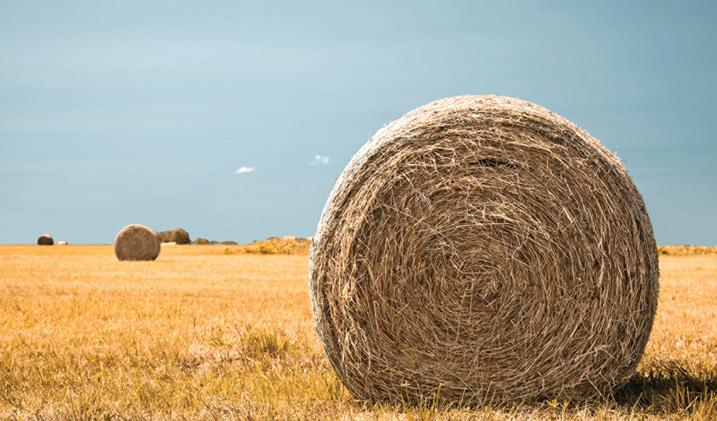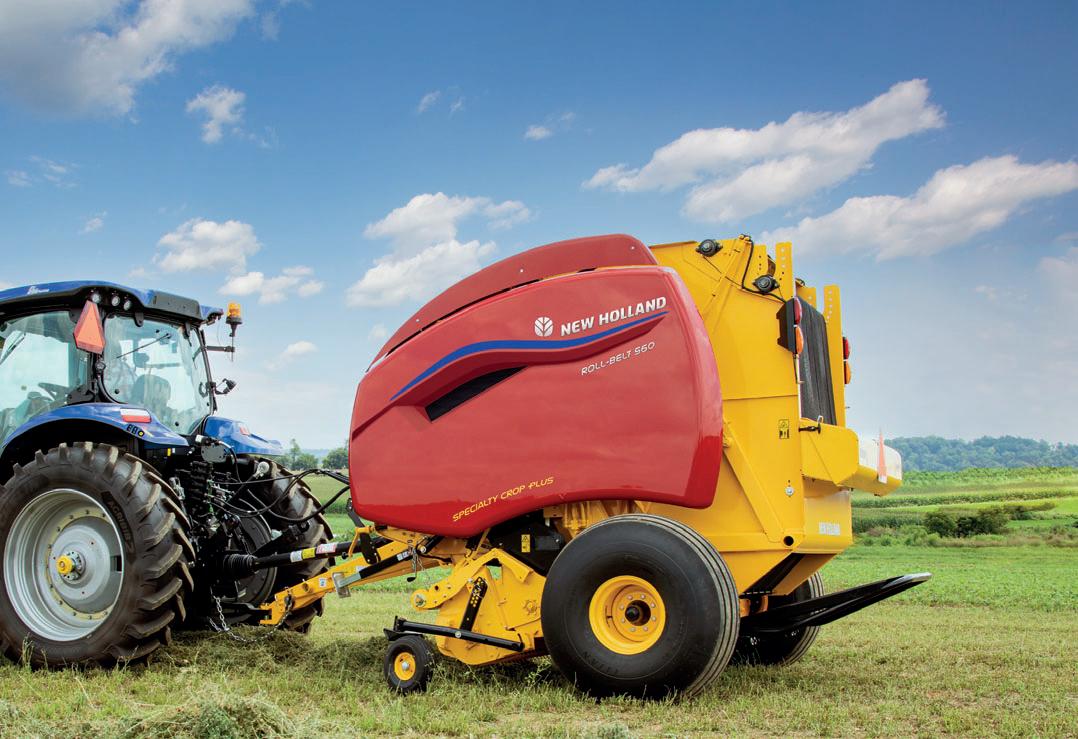Fermentation
by Tyler Rice
I am the type of gardener who is more invested in growing vegetables than actually eating them. This comes at a cost, not only the obvious cost of the inputs like seed, fertilizer and time but also the eventual realization that I’ve grown enough cabbage (and squash and tomatoes) to feed a small army.
This year, to use up the surplus I decided we would try our hand at making sauerkraut.
You can call it my little silage experiment, and in fact, the parallels are unavoidable.

Fermentation is the way certain foods have been preserved for centuries, and in modern livestock production, ensiling bulk forage is nearly irreplaceable in its economy and nutrition.


To ensure silage products are managed in a way that produces a quality product, it is good to understand the biological and chemical processes that occur in the harvest, pre-storage and fermentation phases. A good understanding of these processes can help us to better control feed quality.
Fermentation page 3B
Crunching Crunching
away
BY MAURA WENNER STAFF WRITER



Tucked away in the sandy soils of Little Falls is Foothills Orchard, home to 12,000 apple trees.
Ron Woltjer, owner of the orchard, bought the 16-acre property in 2005. At the time, it was bare land, where he built a shed to start.






“I grew up on a big farm down by Willmar,” said Woltjer, who resides with wife Tai Jen Liu in Sartell. “I am mostly Dutch. My dad and grandfather had a small orchard of about 30 to 40 trees. So, I guess, I kind of got the bug.”




For the fall-driven person, pies,
Foothills Orchard provides apples








crisps and ciders are on the forecast with the arrival of the new harvest season. Woltjer has over 30 varieties of apples to make each recipe complete.
“The University of Minnesota is one of the leading apple breeders in the world right now,” Woltjer said. “Down by Shakopee, they have a research farm where they cross different kinds of apples together. Many crosses are centered around Honeycrisp — a hard, crisp and sweet apple which they developed around 30 years ago.”
AG BENTON Plus Serving rural Benton, Morrison, Mille Lacs and Kanabec counties ROD FLUEGGE “the boss” 2040 Mahogany St., Mora, MN 320-679-2981 Farm Material Handling Specialist FLUEGGE’S AG 1960-2023 Celebrating 63 years! SPREADERS, SPREADERS, SPREADERS... BA37-1B-BL Stop in and speak to Rod! New & Used Spreaders on the lot, ready to go!
University of MN Extension
Sauk Rapids Herald | Saturday, September 16, 2023
PHOTO BY MAURA WENNER Ron Woltjer, owner of Foothills Orchard in Little Falls, stands next to a Honeycrisp apple tree Sept. 11 at his orchard in Little Falls. Woltjer, a Sartell resident, bought the property in 2005 and has since planted 12,000 apple trees along with other fruits and vegetables.
erald
Foothills Orchard page 2B
One section of the orchard contains heirloom apples including Prairie Spy and Wealthy, the rst apple developed in Minnesota in 1868, Woltjer said.
“My favorite variety is Sweet Tango,” Woltjer said. “It’s a cross between Honeycrisp and Zestar. (It’s) the whole package:

pretty, crisp and sweet with 21% sugar. That is what we are known for.”
Woltjer buys University of Minnesota-developed apple trees from an array of nurseries, depending on who has the variety he needs.


“Right now, I am at capacity, but I still buy replacements and sell trees












(320) 584-5520









in spring,” Woltjer said.


One full size tree will grow to be 30-40 feet tall. Woltjer’s trees grow to be about 6-12 feet, because they are dwarf trees.
“They are handy for picking, and they grow apples a lot sooner,” Woltjer said. “I have some trees in their second year growing small apples. Each year, more apples grow and they are bigger. A mature tree grows about 1 bushel of apples.”
Dwarf trees live for around 35 years if they remain healthy. They are relatively low maintenance, but a few diseases and pests do pose a threat.
“I need to spray my apples otherwise probably half a dozen insects would get in,” Woltjer said. “Then, there would be depressions in the apples, or they would have brown trails instead of a white interior from apple maggots.”
Fire blight it is a major disease that can kill an apple tree, and apple scab will leave brown spots.
“I use a fungicide that has a 10-day residual,” Woltjer said. “I haven’t sprayed now since July . If I didn’t, you wouldn’t get a perfect apple. Organic at this scale isn’t practical.”

Woltjer said people with one or two backyard trees can keep insects away organically by


placing plastic bags and rubber bands around each fruit set, but to do so on 16 acres would be quite time consuming. Other threats can also pose problems to orchard owners.
“A hailstorm could dent the apples and cause many to spoil,” Woltjer said. “A strong storm could also cause a heavy branch holding 12 apples to snap. Otherwise, the biggest thing is drought. It is important to keep the trees watered.”
Woltjer has a drip irrigation system that runs along each line of trees. Each evening, the system drips water slowly to provide consistent moisture to the fruit-bearing trees.
“The soil is sandy and not the best place to grow the trees, but we make do,” Woltjer said. “It is also important to choose plants that are hardy and can get through the winter.”

Granny Smith is a green variety of apple he chooses not to grow because it would not fare the colder weather. Yet, Golden Russet does just ne, he said.
“I also keep the property fenced in with an 8-foot-high fence,” Woltjer said. “Otherwise, I would be feeding the deer and rabbits. We put black boots (protective hard plastic) around the trunks to keep rabbits from




them. Last winter, we had so much snow they were chewing on the bark as they were sitting on top of the snow pile.”
When winter begins to set in during early November, the end of the season maintenance is complete.































“We pick every apply at the end of the year off the branches and pick up the ones on the ground,” Woltjer said. “Soft apples like Zestar and Prairie Magic could be shot in two weeks if left on the tree and maybe a month in the refrigerator. But hard apples will last up to six months.”
Pruning the trees begins in March taking around 10 days for four people to complete. Then, the trees ower and are in full bloom during the beginning of May.
“It is fun, but I won’t kid you, it’s a lot of work,” Woltjer said “I have three full-time employees and many part time. I also do a lot of nancial consulting and have an investment practice.”

During harvest season, people come to the orchard to select their favorite apples. Woltjer has posted hours and also books time slots by appointment.

“Many people love coming out and bringing their kids,” Woltjer said. “There is somebody



almost every day picking. We try to do the value-added products too.”









Foothills Orchard participates in the Farm to School nutrition program, picking and sorting many apples to be whisked away to local schools.
“We were given a grant from the Minnesota Department of Agriculture a few years ago for a commercial kitchen,” Woltjer said. “So, we make jams, apple cider, apple juice and apple butter in there. I also have an Amish lady who I hire to bake pies.”


In addition to apples, a variety of plants are grown organically both on the property and in greenhouses, including blueberries, cherries, currants, tomatoes, kiwis, plums, pears, cherries and peppers.
“People can come pick vegetables too,” Woltjer said. “We are also at the St. Cloud and Little Falls farmers markets.”
Out of the 12,000 apple trees, only about 1,500 are producing apples because the majority are young. That means big things to come for Foothills Orchard.
“Really this is my retirement dream,” Woltjer said. “I love it; it is still a job, but it’s fun. And, if you nd a job you love, then it isn’t one at all.”
Page 2B | SATURDAY, SEPTEMBER 16, 2023 | SAUK RAPIDS HERALD BENTON AG BA14-1B-BP P E O P L E...P R O D U C TS...K N OW L E D G E... PEOPLE...PRODUCTS...KNOWLEDGE... Stop in or give us a call for more information! To help serve your seed, application, fertilizer, precision and AgChem needs. Helena Agri-Enterprises, LLC 16250 HWY 10 NW Royalton, MN W E H AV E 3 WE HAVE C E R T I F I E D C R O P A DV I S O R S CERTIFIED CROP ADVISORS
BA2-1B-BL
Foothills Orchard from page 1B
BA35-1B-BL
BA37-1-B-BL
Cash bonus based on 560M round baler w/ pre-cutter. Financing is subject to approval through John Deere Financial. Some restrictions apply. See dealer for details. Offers end September 30, 2023
Sunday morning chores
In full admission, doing chores is not one of my favorite parts of living on a dairy farm. I enjoy caring for the cattle and making certain they are fed well and comfortable, but it’s hard work. We usually have help with the chores and milking, but every other Sunday morning, the chores are my job.
There’s one sliver of light on those days though; my brother-in-law comes to help.
RUMINATIONS WITH MARY MARY BARRON-TRAUT


He is my hubby’s oldest and only brother, and he is fun to listen to. The amazing thing about him is he has been coming on those Sunday mornings for 38 years, and he has only missed a handful of times — and those were mostly due to hunting.
Those mornings begin with my hubby meeting him out in the barn, and while they begin milking, I make coffee and boil water. Once it’s ready, I ll two Yeti thermal cups with coffee and add a few tablespoons of hot chocolate mix for my hubby and me. Next, I ll another cup with boiling water, add a bit of milk, and mix in chocolate syrup for my bro-in-law. The two of them are so appreciative when I bring it to them as they are milking.
At this point in the morning, I help them milk by washing the cows’ teats and moving the milking units. The two talk like they hadn’t been on the phone with one another just the night before, and it’s fun to listen to their conversation. Sometimes, it’s about machinery purchases, prices and repairs; other times, it’s about people they know in common along with a bit of gossip. Seeing the two of them work alongside one another in a natural rhythm makes my heart happy. Also, I know how good these conversations are for my hubby; because my brother-in-law knows the farm and its history, he has someone to bounce ideas off of.
Once the barn cows are bedded with straw, it’s time for me to get on with the other chores. First, it’s feeding the calves. I ll two 2-quart bottles with warm milk from the Surge bucket and hand-hold the bottles as I feed a three-day-old Jersey cross and a one-weekold Holstein who stand side-by-side in the barn. I repeat the process with four other older calves, and then ll several tin pails with milk and feed some calves that have been weaned off the bottle. I check and re ll their feed and water supply for all of the calves in the barn before I bring several pails of milk to the calves housed outside.
As the calves gleefully enjoy their morning energy drink, I check out the chicken coop. I scoop up some wood shavings and a handful of straw to enhance their
Fermentation from page 1B
Time is of the essence. Respiration is a process that plants and microbes go through in order to create energy to live and grow. At a basic level, aerobic respiration involves the capture of oxygen, consumption of sugars and release of carbon dioxide, water and heat. After plants are harvested in the eld, they continue to respire and, in waste, consume valuable dry matter. Wasted energy through respiration when exposed to the air also equates to lost resources for lactic acid bacteria, the key players in fermentation. For these reasons, it is important to limit aerobic respiration and quickly move forage into an anaerobic environment, such as a silage pack.
Lactic acid bacteria is found naturally on crop plant leaf and stem exteriors and are abun-
bedding and am delighted to nd two brown eggs waiting for me. I place them gently in a partial egg carton and put them on the dashboard of my brother-in-law’s truck before heading back to the barn. By this time, they are done milking and are in the milk-house. My bro-in-law stands at the sink washing the milking units, and I stand and listen for a while as the conversation continues.
Next, I head behind the barn to feed the cows. I run the bunk feeder turning on the elevator which conveys the corn silage via a conveyor through the center of the 90-foot-long bunk, so the cattle can feed from either side.
Once that’s complete, I go to the hayshed where our feeder calves are housed; I like to call them teenagers because they aren’t babies anymore, and they aren’t old enough to be bred yet. There are three wooden bunks there, each about 20 feet long, and into them I evenly dump six 5-gallon pails of coarsely ground corn. I’m careful here to avoid any low-hanging spider webs. Because they get their hay from a round bale in the yard, I don’t have to break any open for them, so I take a few minutes to listen to their content chomping and watch for signs of sickness.
I go back to the barn to begin the next task. I stop in the feed room and ll two more 5-gallon pails with a corn-mineral mix for the adolescent calves. I carry them the length of the barn to the lean where those calves are housed. After dumping the feed in their bunk, I throw two bales into the pen and shake out uffy golden straw for their bedding. Lastly, I lug a bale of alfalfa hay into the bunk and break it open for them.
At this point, I check the milk house and discover that my brother-in-law is ready to head home. I share a quick chat with him while he nishes the last of his hot chocolate. I thank him, as I do each time, for coming to help, and he’s on his way — the barn a bit quieter without his booming laugh echoing throughout.
The last of the chores is much easier as my husband helps me to cart wheelbarrows of silage to the barn cows. After we feed them ground corn, one 5-gallon pail to six cows, we shake out some hay, sweep down the alley, and turn out the lights.
The morning chores now complete, we head for the house where I make our breakfast, and he lls me in on the pieces of the conversation with his brother that I missed.
Growing your education
Field Day showcases strip tillage
Wright Soil and Water Conservation District, University of Minnesota Extension and Centra Sota Cooperative are planning a Soil Health Field Day from 4:30-7:30 p.m. Thursday, Sept. 28. This field day will be hosted at Mike Young’s farm at 5430 70th St. SW, Waverly. Attendees may follow extension event signs to the field day location. This field day will be an opportunity to see strip tillage in action. Young will be harvesting sections of his corn field, so participants can see how the equipment prepares the seed bed for planting while leaving residue to protect the soil between the rows. Soil pits will demonstrate how strip tillage affects soil structure, organic matter, plant root growth and more. There will also be presentations on how to utilize soil health management from the agronomic perspective.
The event includes a complimentary dinner. Registration can be made on the event page at z.umn. edu/StripTillFieldDay or by contacting Taylor Herbert at 612-394-5229 or therbert@umn.edu.
Farm Transition and Estate Planning Webinars





The University of Minnesota Extension is presenting four webinars on introductory farm transition and estate planning. Webinars will be Wednesdays from 10 a.m. to noon, beginning Oct. 4. There is no cost to attendees. Attend one or attend all four.



Transferring the farm has many challenges and each situation is unique. David Bau, Nathan Hulinsky and Susanne Hinricks, extension educators in agriculture business management, will discuss several issues and ideas for farm transition and estate planning.
Attendees will receive a link to materials from each session. Participants can register at z.umn.edu/farm-transition-and-estate-planning23.
Topics for each session are as follows:
— Oct. 4 is Developing Your Farm Transition Goals and Assembling Your Team.
— Oct. 11 is All Things
Tax: Gifting, Selling and Transferring.
— Oct. 25 is Wills, Trusts, Ownership Titling; What Does it all Mean?





— Nov. 8 is Putting the Basics Together: Estate, Retirement, Healthcare and Business Transfer Planning.

dant especially in warm temperatures and humid conditions. In silage production, encouraging the preservation and growth of this bacteria post-harvest is critical as it transforms sugars into lactic acid and lowers feed pH to 4-4.2. Lowering pH quickly to lower levels also limits excessive protein-degrading heat caused by overactive bacteria; this is important in preserving forage digestibility. When the pH reaches the desired level and oxygen exposure is minimized, very little microbial action continues to take place and silage reaches a stabilized phase.
Silage-making bacteria present on plant tissue come in two camps: those that produce only lactic acid and those that produce a host of byproducts including lactic acid, acetic acid and ethanol. When sugar
is low the latter type of bacteria tend to transform lactic acid into acetic acid; this happens most often when new feed material is introduced to a pack of stable phase feed. Both acetic acid and ethanol reduce the palatability of the silage. By this, total animal dry matter intake is reduced.



Too much or not enough moisture can be the enemy. When silage is too dry, it is dif cult to create that anaerobic environment because particles cannot adequately seal off air from entering the pack. When silage is harvested too wet and has been contaminated with excess soil or manure, conditions can lead to clostridium bacteria and yeast entering the fermentation process. Clostridium will convert lactic acid into butyric acid causing silage to have higher ammonia-N levels and a putrid smell. Wet silage re-exposed to
oxygen will encourage the growth of yeasts, mold and possibly listeria which can be a major animal health concern.
Additives and inoculants may be more or less helpful depending on the type of activity they promote; this is why it is important to understand the fermentation requirements and processes. Basic best management practices can set up silage pretty well if a producer is monitoring each phase of the process. These are manifested in the harvest and post-harvest environment, exposure to microbes — good and bad, management of oxygen exposure and eventual feed-out protocol.
My little silage experiment in my basement is not so much different, and besides, there is really nothing like a good kraut-dog for dinner when the chores are nished for the day.
SAUK RAPIDS HERALD | SATURDAY, SEPTEMBER 16, 2023 | Page 3B BENTON AG
A calendar of area events to expand agricultural knowledge
TK Timber Turning your logs into USEABLE lumber. 320-266-4909 • Log sawingyour site or ours • Bobcat work • Excavating and site prep services Veteran owned company BA37-1B-RB
240 Main St., Foley MN • (320) 983-2132 Get a quote today! • www.abc-clc.com Join us for our grand re-opening! Thursday Sept. 21 11 am - 2 pm Previously BA37-1B-BL







































































































































































Drought assistance programs 4-H youth exhibit best at the 2023 Minnesota State Fair

With the extremely dry weather we have been experiencing in central Minnesota, we continue to provide Farm Service Agency programs to assist our livestock producers. All producers in Benton, Mille Lacs, Sherburne and Anoka counties can apply for the following programs if applicable to their farming operation.


2023 livestock forage losses



23 receive purple ribbons thus far
BY ANN OLSON University of Minnesota Extension Educator
by Ryan Brunn, executive director for Benton and Mille Lacs counties






Producers are eligible to apply for 2023 Livestock Forage Disaster Program bene ts on small grain, native pasture, improved pasture, annual ryegrass and forage sorghum intended for grazing.
LFP provides compensation if you suffer grazing losses for covered livestock due to drought on privately-owned or cash-leased land or re on federally-managed land.

County committees can only accept LFP applications after noti cation is received by the national of ce of qualifying drought or if a federal agency prohibits producers from grazing normal permitted livestock on federally managed lands due to qualifying re.


Losses from additional cost of transporting water to livestock
If you’ve incurred additional operating costs for transporting water to livestock due to an eligible drought, assistance may be available to you through the Emergency Assistance for Livestock, Honeybees and Farm-Raised Fish Program.
Eligible livestock must be adult or non-adult dairy cattle, beef cattle, buffalo and beefalo as well as alpacas, deer, elk, emus, equine, goats, llamas, reindeer, horses or sheep. Additionally, the livestock must have been owned 60 calendar days prior to the beginning of the drought and be physically located in the county designated as a disaster area due to drought. Adequate livestock watering systems or facilities must have existed before the drought occurred and producers are only eligible if they do not normally transport water to the livestock.
Livestock that were or would have been in a feedlot are not eligible for transporting water. ELAP covers the additional cost of transporting water and does not cover the cost of the water itself.
You must le a notice of loss on form CCC851 the earlier of 30 calendar days of when the loss is apparent to you. Additionally, the deadline to submit an application for payment for 2023 ELAP assistance is Jan. 31, 2024.


You’ll have to provide documentation to FSA that shows the method used to transport the water, the number of gallons of water transported and the number of eligible livestock to which water was transported.









For more information, producers should contact their local county FSA of ce or visit fsa.usda. gov.

4-H youth from across Minnesota again showcased their learning in the 4-H Building at the Minnesota State Fair.
Over 140 demonstrations were delivered and over 1,900 general exhibits were on display. In a continuation of the virtual state showcase format developed in 2020, over 70 of the general exhibits were judged virtually this year.
Throughout the year, 4-H youth select project areas that re ect personal areas of interest and pursue handson learning in both self-directed and guided environments. The results of their learning are exhibited at county fairs and other showcase events across the state. A collection of the best ex-
Brad Herickhoff, Owner 320-351-4872






hibits from each fair and showcase are brought to presentations in the 4-H Building at the Minnesota State Fair.
Exhibiting project work and delivering public presentations at the state fair provides youth an opportunity to
judging


rabbit judging teams. Benton County 4-H’er Maya Rahm, of Foley, receives a purple ribbon for her Mad Cow Disease, or bovine spongiform encephalopathy, poster at the Minnesota State Fair in Falcon Heights. The award was the highest given in the veterinary science division for ninth grades and above.

showcase their achievements and continue learning through interactive conference judging with project experts and team experiences.
The presentations, exhibits and presence of 4-H youth from diverse communities across Min-
nesota brought renewed and welcomed energy to the 4-H Building. See the full results and photos at z.umn.edu/4h-state-fairresults.
Benton County had 117 youth participating in the following areas: 46 livestock exhibitors, 51 general exhibits (up 40% from 2022), six lama exhibitors, ve horse exhibitors, 10 dog exhibitors and seven state shoot exhibitors.
So far with state livestock, state general projects and state llama complete, Benton County 4-H’ers have brought home 23 purple ribbons, 61 blue ribbons, 23 red ribbons and 17 participation green ribbons. Continue to watch for results from state shooting sports, state horse and state dog competitions, which are completed in September.
State fair page 7B
Page 6B | SATURDAY, SEPTEMBER 16, 2023 | SAUK RAPIDS HERALD BENTON AG Farm
Service Agency News
St. Martin, MN • www.lifestylelumber.com • 320-548-3459 • 800-699-9774 Free Estimates • Free Delivery Locally Owned and Operated Owned and • Residential • Agricultural • Light Commercial • Drafting Locally Owned and Operated Let us help you customize your farm Call Randy or Derek Today! ates•FreeDelivery Let us help you Let us you customize your farm customize your farm BA1-tfnB-TV E F F E C T I V E D R A I N A G E EFFECTIVE DRAINAGE CASept2-1B-MT PROFESSIONAL DESIGN. REASONABLE RATES. We Offer Site Prep, Drainage Tile, Land Clearing, Excavation, Pump Stations And So Much More!
BA 37-1B-MT
PHOTOS SUBMITTED
Stearns and Benton County 4-H participants — Henry Miller (from left), Alex Moscho, Regan Listful and Lyla Beehler — combine efforts at the Minnesota State Fair in Falcon Heights. The group earned second in the rabbit
class and fifth overall with















































































































































































































































































































































































































































































